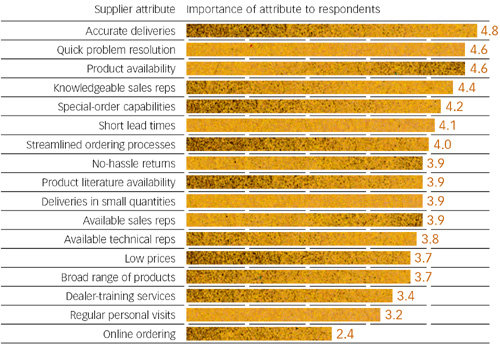As product SKUs have proliferated over the last decade, pro dealer and distribution sales reps in the field have had plenty of specifications, installation recommendations, warranty information, and product sizes, colors, and designs to keep abreast of. “I don’t know how dealer salespeople do it—there are a zillion fasteners, a zillion tools. When you think of the breadth and depth of product lines that they have to be knowledgeable about, it is staggering,” says Ralph Bruno, vice president of sales and marketing for Moosic, Pa.–based AZEK Trimboards.
“When I first started as an outside salesman about 13 years ago, your average supplier’s catalog of products was about the size of PROSALES magazine; it’s now the size of a phone book,” says Greg Rhatican of Alexandria, Va.–based Smitty’s Building Supply. “A couple of us joke around saying, ‘I’d hate to be having to learn all of this stuff from scratch.’”
With seemingly nothing stopping the thirst for new products from the contractor marketplace, it has become increasingly paramount that sales reps in the field are fortified with resources such as product samples and product literature. According to the PROSALES Buying & Selling Practices Study, dealers and distributors put the availability of product literature at 3.9 on a 5-point rating scale where 5 equals “very important” and 1 equals “not at all important.” When asked to select the types of information in manufacturer literature that is most important to them, the highest proportion of respondents indicated new product announcements (69 percent) and/or competitive comparisons (60 percent) (see “Literature 101,” below).
Many manufacturers, including Federal Way, Wash.–based Weyerhaeuser, are also crafting product literature with end-users and alternative audiences in mind. “It’s important to keep literature up to date, and it’s become increasingly important to have it bilingual, as well,” says Weyerhaeuser vice president and general manager of building materials David Still. “You also want to keep product information fresh because of the changing nature of product improvement and potentially even liability if you don’t keep it current.”
And gone are the days of huge loose-leaf catalogs that need to be constantly maintained at the lumberyard. “Years ago there used to be the Sweets catalogs that several manufacturers used,” says Mike Derby, general manager of Dean Lumber in Hollywood, Md. “But the market moves so rapidly today that once you get something edited and ready to print, it’s time to change it. We’re trying to develop electronic catalogs to try to maintain vendor information on CDs and through our Web site.”
At Nashville, Tenn.–based LP Corp., national sales manager, retail group, David Probst says the company maintains a sophisticated supply of marketing literature that can be sent next-day express mail to any of its distribution partners. “We also have fax-on-demand,” says Probst. “So if someone on a jobsite wants specs and properties of 7/16 OSB or 23/32 Orange Plus enhanced flooring, it can be faxed to a laptop on the jobsite in seconds.”

